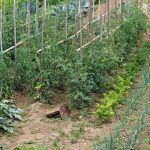Vertical gardens for vegetables have become an increasingly popular trend among urban gardeners and those with limited outdoor space. This innovative gardening method allows for the cultivation of a wide variety of vegetables in a vertical, space-saving manner. In this article, we will explore the concept of vertical gardens for vegetables and delve into the benefits of growing vegetables in this unique way.
Vertical gardening involves growing plants vertically, either on a wall, trellis, or other structure, rather than horizontally in traditional garden beds. This method not only maximizes space but also presents an opportunity to create a visually stunning and practical garden. When it comes to vegetables, vertical gardens offer numerous advantages such as efficient use of space, easier maintenance, and better pest and disease control.
In the following sections, we will explore how to select the right vegetables for vertical gardens and provide tips for designing and building your own vertical vegetable garden. Additionally, we will discuss how to properly maintain your vertical garden and address common issues that may arise.
Furthermore, we will highlight success stories and provide inspiration for readers looking to embark on their own vertical garden journey. Whether you are new to gardening or simply looking for a fresh approach to vegetable cultivation, vertical gardens offer an exciting opportunity to explore the world of sustainable and space-efficient gardening.
Choosing the Right Vegetables for Vertical Gardens
When it comes to choosing the right vegetables for vertical gardens, there are several factors to consider. Not all vegetables are well-suited for vertical gardening, so it’s important to select varieties that will thrive in this environment. Some of the best vegetables for vertical gardens include:
- Tomatoes: Vine or indeterminate varieties of tomatoes are perfect for vertical gardens. These plants can be trained to grow up a trellis or other support structure, making them ideal for saving space.
- Cucumbers: Another vining plant, cucumbers do well in vertical gardens. Look for compact or bush varieties that won’t take up too much space.
- Peppers: Both sweet and hot peppers can be grown in vertical gardens. Compact varieties work best and can be easily trained to grow vertically.
When selecting vegetables for your vertical garden, it’s important to consider the amount of space they will need to grow, as well as their sunlight and water requirements. Additionally, some vegetables may need additional support as they grow, so be sure to plan for this when designing your vertical garden.
To ensure a successful harvest from your vertical garden, it’s also important to choose vegetables that you and your family enjoy eating. Consider what produce you typically use in your cooking and focus on growing those items in your vertical garden.
Remember that with care and maintenance, you can grow a wide variety of delicious vegetables in a vertical garden, even if you have limited outdoor space. Start planning now and soon you’ll be enjoying fresh produce from your own vertical garden for vegetables.
Designing Your Vertical Garden
When it comes to designing a vertical garden for vegetables, there are several factors to consider in order to create a successful and thriving growing space. One of the key elements to keep in mind is the selection of the right materials for building your vertical garden. The choice of materials will not only affect the overall aesthetic appeal of your garden, but also its functionality and longevity.
For a sturdy and durable vertical garden, materials such as weather-resistant wood, metal frames, or PVC piping are ideal choices. These materials can withstand the weight of the plants and provide a stable structure for your vertical garden. It’s also important to consider the water drainage system in your design, ensuring that excess water can easily flow out without causing damage to the structure or plants.
In addition to the material selection, another crucial aspect of designing your vertical vegetable garden is determining the layout and positioning of the plants. Take into account factors such as sunlight exposure, wind direction, and accessibility for watering and maintenance when arranging your vegetable plants in the vertical garden. Proper planning at this stage will contribute to the overall success of your vertical garden for vegetables.
Finally, incorporating trellises, hanging baskets, or modular planting systems can add versatility and functionality to your vertical garden design. These elements allow for better organization of different types of vegetables, efficient use of space, and easy access for harvesting. By carefully considering these design aspects, you can create an efficient and visually appealing vertical garden for growing vegetables.
| Vertical Garden Material | Ideal Features |
|---|---|
| Weather-resistant wood | Durable and visually appealing |
| Metal frames | Sturdy support for plants |
| PVC piping | Lightweight yet durable option |
Building Your Vertical Garden
Vertical gardens for vegetables have become increasingly popular in recent years, especially among urban dwellers and those with limited outdoor space. Constructing a vertical garden for vegetables is an excellent way to maximize your space and grow your own fresh produce. Whether you live in an apartment with a balcony or a house with a small backyard, building a vertical garden can provide you with the opportunity to harvest your own fruits and vegetables.
To start building your vertical garden, the first step is to select the right location. Look for areas that receive adequate sunlight and are easily accessible for watering and maintenance.
Once you’ve chosen the perfect spot, it’s important to gather the necessary tools and materials. Some of the essential items needed for building a vertical garden include a sturdy support structure such as trellises or wall-mounted planters, quality potting soil, and of course, the vegetable plants or seeds of your choice.
When constructing your vertical garden, it’s crucial to ensure that the structure is stable and secure. Depending on the type of support system you choose, you may need to install brackets or hooks to hold the planters in place.
It’s also important to consider factors such as irrigation and drainage to keep your vegetable plants healthy and thriving. Following a step-by-step guide will help you build a strong and functional vertical garden that will provide you with an abundance of fresh vegetables.
Overall, building a vertical garden for vegetables requires careful planning and attention to detail. By selecting the right location, gathering the necessary tools and materials, and following proper construction techniques, you can create a beautiful and productive space for growing your own delicious produce. Vertical gardens for vegetables offer an innovative solution for maximizing space while enjoying all the benefits of gardening at home.
Maintaining Your Vertical Garden
Proper maintenance for vegetable plants in a vertical garden is essential for ensuring a bountiful harvest. One of the main advantages of vertical gardens for vegetables is that they require less maintenance compared to traditional gardens. With the right care, your vertical garden can provide you with a steady supply of fresh produce throughout the growing season.
Regular watering and fertilizing are crucial for the health of plants in a vertical garden. Since the soil in vertical gardens tends to dry out more quickly, it’s important to monitor the moisture levels closely and water as needed. Additionally, using a slow-release fertilizer or organic compost can help nourish the vegetables as they grow.
Common issues that may arise in vertical gardens for vegetables include pest infestations, leaf discoloration, and stunted growth. To address these problems, regularly inspect your plants for signs of pests or disease, and take action as soon as any issues are spotted. Additionally, providing adequate support for vining crops such as tomatoes and cucumbers will help prevent them from becoming overcrowded and stressed.
Maximizing Space With Vertical Gardens
Vertical gardens offer an inventive solution for individuals with limited space who still want to enjoy growing their own vegetables. By utilizing vertical space effectively, even those with small yards or urban living arrangements can experience the satisfaction of homegrown produce. In fact, research shows that vertical gardens have been successful in reducing urban heat island effect by adding greenery to cities.
Whether you’re interested in growing herbs, leafy greens, or even compact fruit varieties like strawberries, there are numerous options available for incorporating vertical gardens into your space. This method not only adds visual interest but also provides practical benefits by allowing you to capitalize on unused wall space while creating an attractive focal point in your outdoor area.
| Vegetable | Best Growing Conditions |
|---|---|
| Tomatoes | Full sun; sturdy trellis support |
| Lettuce | Partial shade; well-drained soil |
| Cucumbers | Full sun; ample room to vine |
This table highlights some common vegetables suitable for vertical gardening along with their best growing conditions to help you make informed decisions when selecting plants for your own vertical garden setup.
Maximizing Space With Vertical Gardens
Vertical gardens are an innovative way to maximize space in small yards or urban areas. By utilizing vertical space, gardeners can grow a variety of vegetables without taking up valuable ground space. This method is especially beneficial for those living in apartments or homes with limited outdoor area. Vertical gardens for vegetables allow individuals to enjoy the benefits of gardening and homegrown produce, even with space constraints.
When it comes to vertical gardens for vegetables, one of the key advantages is the ability to save space. By growing upwards instead of outwards, gardeners can make the most of their available area. This is particularly useful for individuals who may only have a small balcony or patio to work with. Additionally, vertical gardens provide an opportunity to add visual interest and greenery to urban environments, enhancing the aesthetic appeal of outdoor spaces.
One effective way to utilize vertical space for vegetable gardening is by incorporating tiered or stacked planting systems. This allows for multiple layers of plants to be grown in a compact and organized manner. The use of hanging planters, trellises, and wall-mounted containers also helps maximize vertical space while creating a lush and thriving garden. Here are some ideas for maximizing space with vertical gardens:
- Utilize wall-mounted planters or shelves
- Install a vertical planter that can be hung on a balcony railing
- Incorporate a tiered planting system using stacked containers
- Build a trellis or support structure for climbing vegetable plants
With these creative solutions, even those with limited outdoor space can enjoy the satisfaction of growing their own fresh vegetables right at home.
By implementing vertical gardens for vegetables, individuals can experience the joy of gardening while making efficient use of their available space. Whether it’s a small urban balcony or a compact backyard, vertical gardening offers an accessible way to grow an abundance of fresh produce within a limited area. With the right planning and design, anyone can create a flourishing vegetable garden despite spatial restrictions.
Harvesting and Enjoying Your Vertical Garden Vegetables
Tips for Harvesting Vegetables From a Vertical Garden
When it comes to harvesting vegetables from a vertical garden, it is important to do so at the right time to ensure optimal flavor and nutrition. Different vegetables have different harvesting times, and it’s crucial to be aware of when each type of vegetable is ready for picking.
For example, tomatoes should be harvested when they are fully colored but still firm, while leafy greens like lettuce can be harvested when the leaves are large enough to eat. Additionally, remember to use clean gardening shears or scissors to cut the vegetables, as this will help prevent damage to the plants.
Ideas for Using Fresh Produce From Your Vertical Garden
After harvesting your vegetables from the vertical garden, there are countless ways to enjoy and make the most out of your fresh produce. You can use them in salads, stir-fries, soups, and sandwiches. You can also pickle or ferment them for longer shelf-life and added flavor.
Another great idea is to blend fruits and vegetables together into delicious smoothies or juices for a healthy treat. With a wide variety of culinary possibilities available, growing your own fruits and vegetables in a vertical garden not only ensures their freshness but also adds an exciting new dimension to your cooking.
Preserving Excess Produce
If you find yourself with an excess of produce from your vertical garden, consider preserving them for later use. You can freeze or can some types of vegetables for long-term storage so that you can enjoy your homegrown harvest even during the off-seasons.
Additionally, consider sharing your excess produce with friends and family or donating it to local food banks. This not only helps reduce food waste but also spreads the joy of home-grown produce within your community.
By following these tips for harvesting and using the fresh produce from your vertical gardens for vegetables, you can ensure that you get the most out of your homegrown bounty. Whether enjoying them fresh in meals or preserving them for future use, there are countless ways to savor the flavors of your hard-earned harvest.
Success Stories and Inspiration
Real-Life Examples of Successful Vertical Garden Vegetable Projects
There are countless success stories of people who have created thriving vertical gardens for vegetables. From urban dwellers with limited outdoor space to suburban homeowners looking to maximize their garden area, these individuals have found creative ways to grow an abundance of produce in a vertical setup. One such example is the community garden in downtown New York City, where volunteers transformed a barren wall into a lush oasis of tomatoes, lettuce, and herbs.
Another inspiring story comes from a family in a small apartment building, who utilized their balcony to cultivate peppers, strawberries, and various leafy greens. These real-life examples serve as testimony to the potential of vertical gardens for vegetables.
Inspiring Stories of People Growing Vegetables in Vertical Gardens
The stories of individuals who have successfully grown vegetables in vertical gardens are not only impressive but also highly motivating for those considering starting their own project. One particularly remarkable account is that of a retired couple who turned their boring backyard fence into a flourishing vegetable garden using simple wooden trellises and hanging planters. Their dedication and ingenuity resulted not only in an aesthetically pleasing display but also in an abundant supply of fresh produce throughout the growing season.
Another inspiring tale comes from a schoolteacher who launched a vertical gardening program for her students. By incorporating vertical gardens into their science curriculum, she not only fostered an appreciation for sustainable agriculture but also provided the school cafeteria with an ongoing source of organic fruits and vegetables. These uplifting accounts demonstrate how diverse and impactful the use of vertical gardens for vegetables can be.
The success stories and inspiring anecdotes shared here illustrate the limitless potential of vertical gardens for vegetables. Whether you are seeking to create your own small-scale urban oasis or hoping to make more efficient use of your available garden space, these tales offer encouragement and inspiration. By learning from others’ experiences and accomplishments, you too can embark on your own rewarding journey with vertical gardening for vegetables.
Conclusion
In conclusion, vertical gardens for vegetables offer a multitude of benefits that make them an excellent option for those looking to grow their own produce. The concept of vertical gardens not only maximizes space but also allows for greater flexibility and creativity in gardening. By utilizing vertical space, individuals can cultivate a wide variety of vegetables while saving precious ground space.
Choosing the right vegetables for vertical gardens is crucial in ensuring a successful harvest. Factors such as the size and weight of the plants, as well as their growth habits, need to be taken into consideration. Additionally, proper care and maintenance are essential for the health and productivity of the vegetable plants in a vertical garden. Understanding how to troubleshoot common issues such as pest infestations or nutrient deficiencies is key to a thriving vertical garden.
Ultimately, the potential for success with vertical gardens for vegetables is endless. From small urban yards to balconies, anyone can create their own flourishing edible oasis using vertical gardening techniques. With careful planning, thoughtful design, and proper maintenance, individuals can enjoy a bountiful harvest of fresh and delicious produce from their very own vertical garden. So why not take the plunge and embark on your own journey towards growing vegetables in a stunning and productive vertical garden?
Frequently Asked Questions
What Vegetables Can You Grow Vertically?
You can grow a variety of vegetables vertically, including tomatoes, cucumbers, peppers, and beans. These plants typically have vining or trailing growth habits that make them suitable for vertical gardening.
How Do You Build a Vertical Vegetable Garden?
To build a vertical vegetable garden, you’ll need to choose a suitable location with adequate sunlight and access to water. Then, you can construct a support structure such as trellises, stakes, or cages for the plants to climb. Using containers or planters that are designed for vertical gardening can also be helpful.
Are There Any Drawbacks to Using Vertical Gardens?
While vertical gardens offer many benefits, there are some drawbacks to consider. One potential issue is the need for regular maintenance, as these gardens may require more frequent watering and monitoring than traditional gardens.
Another drawback is the potential for reduced yields compared to conventional gardening methods due to space limitations. Additionally, certain crops may not thrive in a vertical growing environment.

If you’re looking to get into vegetable gardening, or are just looking for some tips on how to make your current garden better, then you’ve come to the right place! My name is Ethel and I have been gardening for years. In this blog, I’m going to share with you some of my best tips on how to create a successful vegetable garden.





